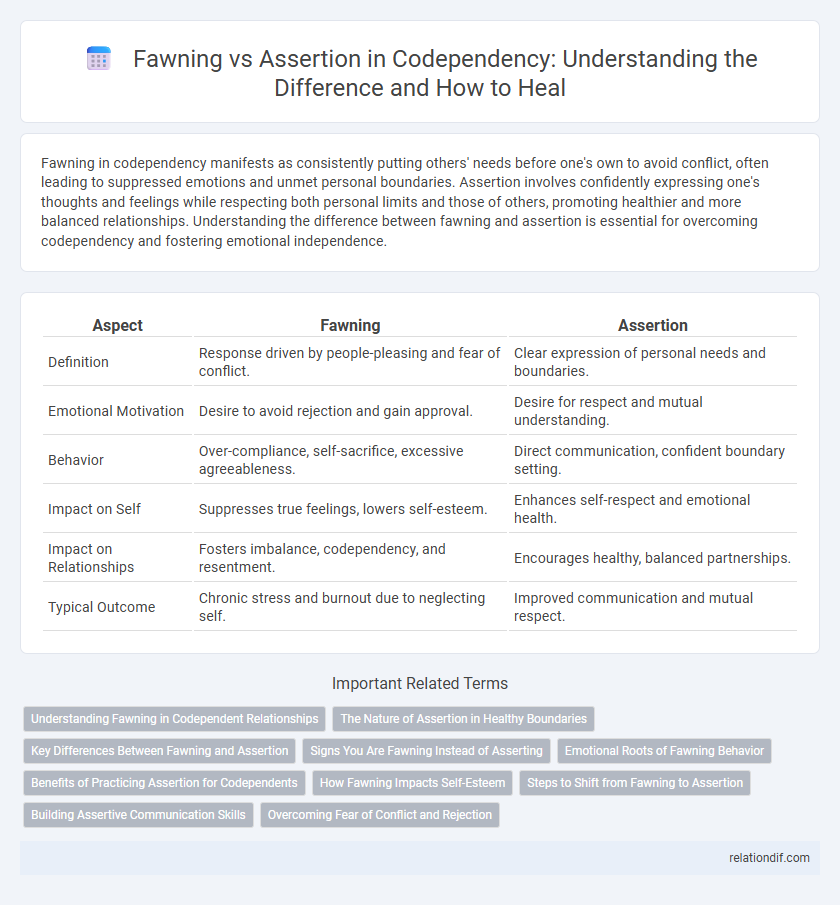Fawning in codependency manifests as consistently putting others' needs before one's own to avoid conflict, often leading to suppressed emotions and unmet personal boundaries. Assertion involves confidently expressing one's thoughts and feelings while respecting both personal limits and those of others, promoting healthier and more balanced relationships. Understanding the difference between fawning and assertion is essential for overcoming codependency and fostering emotional independence.
Table of Comparison
| Aspect | Fawning | Assertion |
|---|---|---|
| Definition | Response driven by people-pleasing and fear of conflict. | Clear expression of personal needs and boundaries. |
| Emotional Motivation | Desire to avoid rejection and gain approval. | Desire for respect and mutual understanding. |
| Behavior | Over-compliance, self-sacrifice, excessive agreeableness. | Direct communication, confident boundary setting. |
| Impact on Self | Suppresses true feelings, lowers self-esteem. | Enhances self-respect and emotional health. |
| Impact on Relationships | Fosters imbalance, codependency, and resentment. | Encourages healthy, balanced partnerships. |
| Typical Outcome | Chronic stress and burnout due to neglecting self. | Improved communication and mutual respect. |
Understanding Fawning in Codependent Relationships
Fawning in codependent relationships manifests as excessive people-pleasing and self-sacrifice to avoid conflict and gain approval, often leading to suppressed emotions and unmet needs. This behavior contrasts with assertion, which involves expressing personal boundaries and needs clearly and respectfully. Recognizing fawning tendencies is crucial for breaking unhealthy patterns and fostering balanced, authentic connections.
The Nature of Assertion in Healthy Boundaries
The nature of assertion in healthy boundaries involves confidently expressing one's needs and feelings without fear of rejection or conflict. It empowers individuals to maintain self-respect and foster mutual respect in relationships, contrasting sharply with fawning behavior, which seeks approval through appeasement. Assertion promotes emotional autonomy and clear communication, essential components for breaking codependent patterns.
Key Differences Between Fawning and Assertion
Fawning involves excessive people-pleasing and avoidance of conflict to gain approval, while assertion emphasizes expressing personal needs and boundaries confidently and respectfully. Unlike fawning, assertion promotes healthy self-esteem and honest communication without fear of rejection. Key differences revolve around self-expression: fawning sacrifices authenticity for acceptance, whereas assertion maintains integrity and mutual respect.
Signs You Are Fawning Instead of Asserting
Signs you are fawning instead of asserting include constantly prioritizing others' needs over your own, avoiding conflict by agreeing even when you disagree, and suppressing personal opinions or boundaries to maintain peace. You may notice a pattern of people-pleasing behaviors, feeling anxious about disappointing others, and difficulty expressing genuine thoughts or feelings. This often leads to a loss of self-identity and increased emotional exhaustion.
Emotional Roots of Fawning Behavior
Fawning behavior in codependency often stems from deep-seated fears of rejection and abandonment, leading individuals to prioritize others' needs over their own to maintain relationships. This emotional pattern develops as a survival mechanism in response to past trauma or inconsistent caregiving, imprinting a learned response to avoid conflict through excessive compliance. Understanding these emotional roots distinguishes fawning from healthy assertion, which involves expressing personal boundaries and needs confidently without fear of negative consequences.
Benefits of Practicing Assertion for Codependents
Practicing assertion empowers codependents to establish clear personal boundaries, reducing feelings of resentment and burnout commonly associated with fawning behaviors. Assertion enhances self-confidence and emotional regulation, enabling healthier communication and more balanced relationships. Consistent assertive practice promotes autonomy, helping codependents shift from people-pleasing tendencies toward genuine self-expression and mutual respect.
How Fawning Impacts Self-Esteem
Fawning behaviors in codependency often lead to diminished self-esteem as individuals prioritize others' approval over their own needs and desires. This pattern fosters a chronic sense of inadequacy and self-doubt, eroding personal confidence and autonomy. In contrast, assertion promotes healthy boundaries and self-respect, vital for rebuilding self-worth in codependent relationships.
Steps to Shift from Fawning to Assertion
Shifting from fawning to assertion involves recognizing and honoring personal boundaries while practicing direct communication techniques that express authentic needs clearly and respectfully. Building self-awareness through journaling and mindfulness helps identify moments of automatic people-pleasing, enabling conscious choices to stand firm in one's values. Consistent role-playing assertive responses and seeking supportive feedback fosters confidence in expressing dissent without fear of rejection or conflict.
Building Assertive Communication Skills
Fawning behaviors in codependency often involve excessive people-pleasing and suppressing personal needs to avoid conflict, which undermines healthy communication. Building assertive communication skills empowers individuals to express their thoughts and boundaries clearly while respecting others, promoting emotional balance and self-respect. Practicing techniques such as using "I" statements, maintaining eye contact, and setting firm limits helps transition from fawning patterns to confident, authentic interactions.
Overcoming Fear of Conflict and Rejection
Overcoming fear of conflict and rejection in codependency involves shifting from fawning--where one excessively pleases others to avoid disapproval--to healthy assertion, which emphasizes clear and respectful communication of personal boundaries and needs. Embracing assertiveness builds self-confidence and reduces dependence on external validation, fostering emotional independence and balanced relationships. Consistent practice of assertive techniques helps break the cycle of accommodating behaviors driven by fear, empowering individuals to handle disagreements constructively without compromising their values.
Fawning vs Assertion Infographic

 relationdif.com
relationdif.com